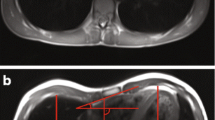Abstract
Objective
The objective of this study was to characterize the different causes of prolonged sternal pain following thoracic trauma with involvement of the sternum and to define criteria for sternal nonunion diagnosis using MRI.
Design and patients
Five patients with abnormalities of the sternum were evaluated for prolonged sternal pain following thoracic trauma using MRI. MR images were evaluated by two radiologists in consensus. The patients were selected from the radiology database, which included 8 patients with post-traumatic prolonged sternal pain.
Results
Two patients (n = 2) revealed a sternal nonunion after sternal fracture. One patient had a sternal fracture with delayed union and minor displacement of the sternal halves. Abnormal signal intensity alterations adjacent to and within the manubrio-sternal joint were evident in 2 patients and considered due to trauma-related changes in the manubrio-sternal joint. The 3 patients who were not included in the study had no abnormalities of the sternum: 1 of them proved to have a well-healed sternal fracture and nonunion of a rib fracture, 1 had subtle Tietze’s syndrome, and 1 patient revealed no pathological findings on imaging.
Conclusion
Various factors may be responsible for prolonged sternal pain following thoracic trauma, and these can be viewed with MRI. In cases of sternal nonunion there was common fluid-like signal in the fracture interspace between the bony edges, and the bone marrow adjacent to the nonunion showed altered signal intensity. MRI identified sternal nonunion and other trauma-related abnormalities of the sternum following chest trauma.





Similar content being viewed by others
References
Hensinger RN, Berkoff HA. Traumatic non-union of the sternum. J Trauma 1975;15(2): 159–162.
Mayba II. Sternal injuries. Orthop Rev 1986;15(6): 364–372.
Mayba II. Non-union of fractures of the sternum. J Bone Joint Surg Am 1985;67(7): 1091–1093.
Coons DA, Pitcher JD, Braxton BT. Sternal nonunion. Orthopedics 2002;25(1): 89–91.
Lichtman HM, Silver CM, Simon SD, Tamura H. Post-traumatic degenerative arthrosis in the manubriosternal joint. Clin Orthop Relat Res 1969;67: 111–115.
Kalicke T, Frangen TM, Muller EJ, Muhr G, Hopf F. Traumatic manubriosternal dislocation. Arch Orthop Trauma Surg 2006;126(6): 411–416.
Marsh D. Concepts of fracture union, delayed union, and nonunion. Clin Orthop Relat Res 1998;355: 22–30.
Bartels KE. Nonunion. Vet Clin North Am Small Anim Pract 1987;17(4): 799–809.
DeAngelis MP. Causes of delayed union and nonunion fractures. Vet Clin North Am 1975;5(2): 251–258.
Boer FC, Patka P, Bakker FC, Haarman HJ. Current concepts of fracture healing, delayed unions, and nonunions. Osteo Trauma Care 2002;10: 1–7.
Einhorn TA. The science of fracture healing. J Orthop Trauma 2005;19(10): 4–6.
Wu LC, Renucci JD, Song DH. Sternal nonunion: a review of current treatments and a new method of rigid fixation. Ann Plast Surg 2005;54(1): 55–58.
Hendrickson SC, Koger KE, Morea CJ et al. Sternal plating for the treatment of sternal nonunion. Ann Thorac Surg 1996;62: 512–518.
Templeton PA, Fishman EK. CT evaluation of poststernotomy complications. AJR Am J Roentgenol 1991;159: 45–50.
Li AE, Fishman EK. Evaluation of complications after sternotomy using single- and multidetector CT with three-dimensional volume rendering. AJR Am J Roentgenol 2003;181: 1065–1070.
Bitkover CY, Cederlund K, Aberg B, Vaage JV. Computed tomography of the sternum and mediastinum after median sternotomy. Ann Thorac Surg 1999;68: 858–863.
Kurzweg FT, Danna SJ, Lolley RT. Open reduction and fixation of a comminuted fracture of the sternum. J Thorac Cardiovasc Surg 1972;63: 424–426.
Gibson LD, Carter R, Hinshaw DB. Surgical significance of sternal fracture. Surg Gynecol Obstet 1962;114: 443–448.
Bitkover CY, Gardlund B. Mediastinitis after cardiovascular operations: a case-control study of risk factors. Ann Thorac Surg 1998;65: 36–40.
Velutini JA, Tarazona PF. Fracture of the manubrium with posterior displacement of the clavicle and first rib. A case report. Int Orthop 1998;22(4): 269–271.
Destouet JM, Gilula LA, Murphy WA, Sagel SS. Computed tomography of the sternoclavicular joints and sternum. Radiology 1981;138(1): 123–128.
Author information
Authors and Affiliations
Corresponding author
Rights and permissions
About this article
Cite this article
Grosse, A., Grosse, C., Steinbach, L. et al. MRI findings of prolonged post-traumatic sternal pain. Skeletal Radiol 36, 423–429 (2007). https://doi.org/10.1007/s00256-007-0277-7
Received:
Revised:
Accepted:
Published:
Issue Date:
DOI: https://doi.org/10.1007/s00256-007-0277-7




